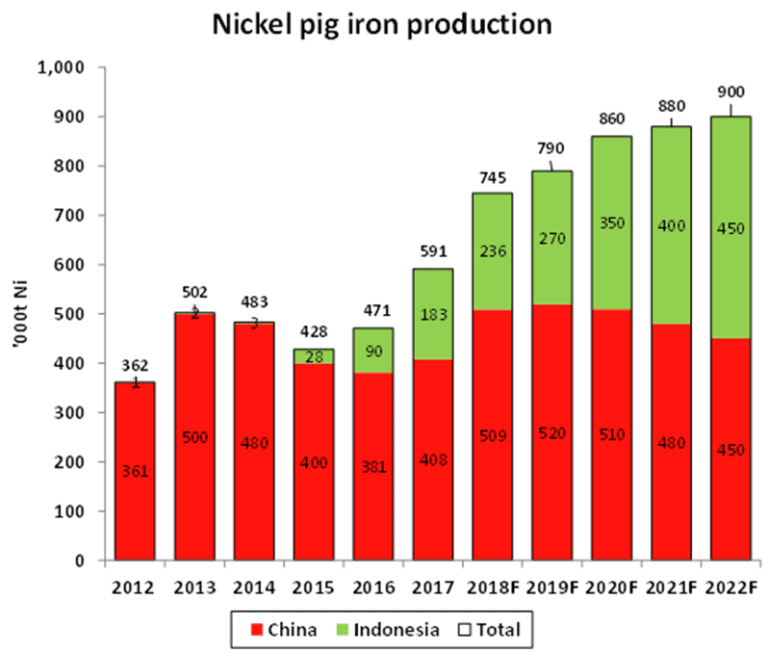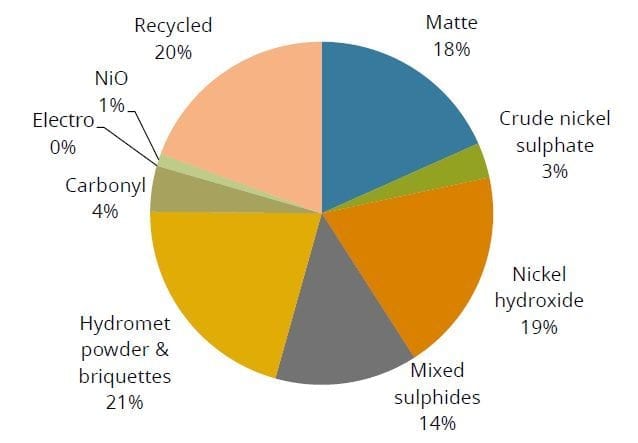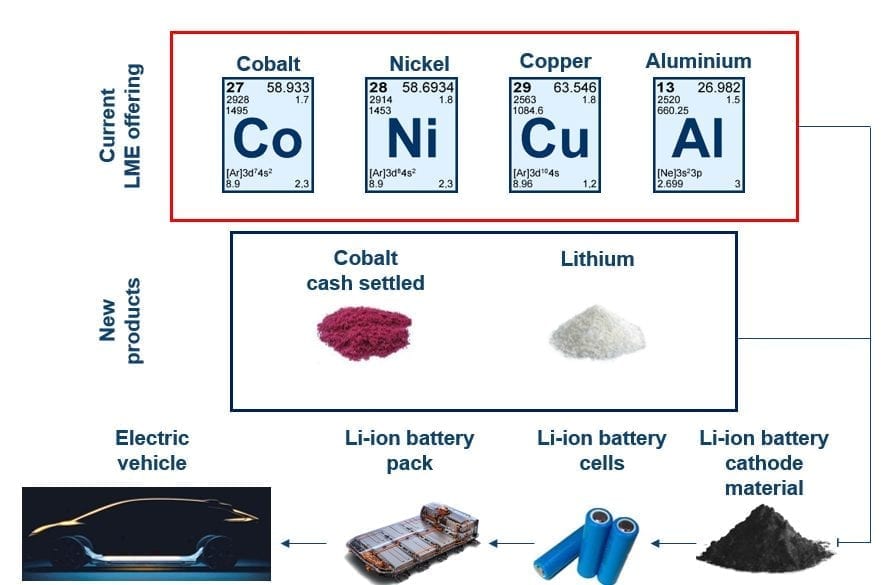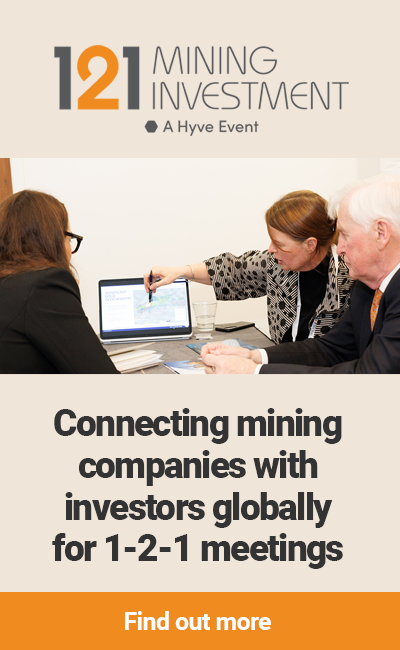Nickel demand for stainless steel has been the main driver of growth in past decades, with much attention given to the breakdown between 200 Series (low Ni-Mn), 300 Series (austenitic, 18Cr/8Ni) and Duplex Grades (austenitic-ferritic) as the underlying nickel demand drivers. But nickel is entering new territory, with sharper differentiation between Class I (pure Ni products listed on LME and SHFE Exchanges) and lower purity Class II products, for which Ni content is traded at a discount to prevailing LME prices.
Greater separation will be driven by the fast-growing market for rechargeable batteries, especially for electric vehicles (EV’s) opposite the traditional stainless steel market which is serviced by ferro-nickel, nickel pig iron (NPI) and nickel oxides. In consequence, mining companies, producers of intermediate products, plus manufacturers of inorganic chemicals, precursors and batteries for automotive OEMs, are now revising their view of opportunities and threats.
Product Segmentation – NPI
Over the past decade innovative Chinese production of low-cost nickel pig iron (NPI) from imported laterite ores was a major factor in nickel prices falling from highs of around USD 30,000 pmt in 2011 to around USD 10,000 pmt average last year. Outlook for 2018 globally is production of 2.19 million tonnes and consumption of 2.27 million tonnes leading to a deficit of 80 kt (SMM data) following deficits of 131 kt in 2017 and 34 kt in 2016
Nickel prices have lifted by >40% since June 2017, although rising production of NPI in China after the easing of Indonesia’s ore export ban, plus new production of NPI on-site in Indonesia may curb these gains. China’s output of NPI in 2018 will probably be 509 kt plus that in Indonesia, for a total of 745 kt Ni content.
Product Segmentation – Feed for Batteries
Consumption for batteries in 2018 could be 100 kt compared to about 50 kt in 2017. With Government policies now encouraging innovation in EVs, lower costs are on the horizon and many countries have announced deadlines for transition to EV, combining to provide a solid driving force for nickel. Analysts’ forecast for global production of passenger and light commercial electric vehicles (EVs) varies from 10 to 20% of annual sales through to 2025. Future battery costs will be governed by technology and production improvements with uptake influenced by the availability of charging and servicing facilities. Consensus view is that nickel growth will be rapid, driven by NMC ( nickel, manganese, cobalt) and NCA ( nickel, cobalt, aluminium) cathode chemistries. While developed for the EV industry with high performance and increasingly competitive cost, they may well find wider use in other battery applications such as storage and portable products.
Fig 1. Nickel Pig Iron Production Outlook.

Fig 2. Nickel Containing Chemistries Offer Highest Energy Density.

Fig 3. Cathode Chemistry of NCA and NMC Batteries.

Fig 4. Nickel’s Share of Li-Ion Batteries Will Grow.

In Summary
- NMC is likely to become the most common battery chemistry of the future, as most EV manufacturers favour this chemistry.
- NCA is classic Panasonic chemistry used by Tesla.
EV battery cathodes that contain nickel sulphate (NiSO4.6H2O) with 22% Ni minimum can be produced from a variety of sources:
- An intermediate such as a mixed hydroxide or sulphide product (MHP/MSP) from laterite ores. Where the nickel is priced at a significant discount to LME and is accompanied by valuable cobalt content.
- Crude nickel sulphate (CNS) from copper and PGM refineries.
- Dissolution of pure nickel powder, pellets or briquettes in sulphuric acid.
- Other routes include dissolution of matte or oxides.
- Lastly, even cut nickel cathodes (behind protective duty barriers on imported nickel sulphate, as in India)
High purity nickel sulphate has a long history of use for electrodeposition and electroless nickel plating (150 kt gross of NiSO4 = 33 kt Ni in 2017), and this same quality product is required for cathode precursors for Li-ion batteries. Much will depend upon technologies able to produce the minimum 22% Ni content NiSO4.6H2O product, utilising a choice of feed for chemical producers who are reliant upon third party sources; to mitigate the risk of change in availability or chemistry and also take advantage of price arbitrage opportunities. For example, Alpha Fine Chemicals Ltd plan a 20,000 tpy plant at Kwinana, West Australia, to produce high purity nickel sulphate free of metallic impurities and with low total organic carbon (TOC) suitable for both plating and battery precursors with valuable co-products: cobalt carbonate (99.9% min) and magnesium sulphate.
Presently the premium of the Ni metal content in nickel sulphate for the battery and plating industries in Asia is USD 2,500 to 4,000 pmt CIF, compared with USD 300 to 1,500 pmt CIF for most Class I nickel (depending on product form and packing).
Fig 5. Use of Intermediates, Finished Nickel Products and Recycled Scrap for Production of Nickel Sulphate.

Looking Ahead: Nickel for Plating
While all other nickel consuming industries have a positive outlook, there is a cloud on the horizon for decorative nickel plating which represents about 8% of all consumption, but is especially attractive because of the high premiums it yields for Class I nickel and salts. The European Chemical Agency (ECHA) is the Regulatory body for the European Union, and they have issued draft guidelines listing articles that may be restricted from placement on the market in the EU, for fear of causing contact dermatitis. But recent research shows there is no problem when plated with decorative nickel and finished with a normal top coat of chromium or an organic.
Fig 6. A Process That Uses Various Feedstock to Consistently Produce Quality Nickel Sulphate.

Risk Management
Reference pricing and on-exchange trading are natural steps in development of the battery industry and offers the advantage of simplifying annual negotiation of contracts involving premia/discounts. There is no basis risk when hedging and future price expectations are visible for better planning. For example, the LME is positioned to service the growing EV battery industry.
Fig 7. Existing Metal Contracts and Proposed New Products.

Outlook
The nickel market remains in deficit following a large supply shortfall of 131 kt in 2017, with booming production of 300 Series austenitic stainless steel and strong demand from the battery sector combining to give global nickel growth of 8.3 % last year. (INSG data), and strong demand continuing in 2018.
On the supply side, non-Chinese primary nickel production has slid by closures and disruptions, while on the other hand higher Indonesian and Chinese NPI plus some restarts (Falcondo, Doniambo) may rebalance the market in H2 2018. But in the meantime, the outlook for nickel remains strong, with use in EVs adding a further 30 kt Ni content this year. While global growth and rising raw material prices could lead to a longer than expected restocking cycle in stainless steel with upward pressure on stainless steel end-use prices.












